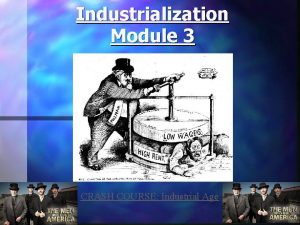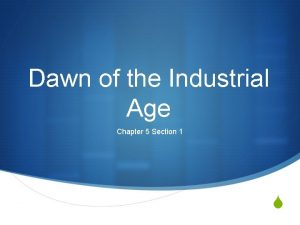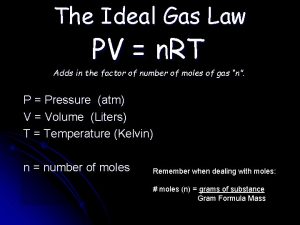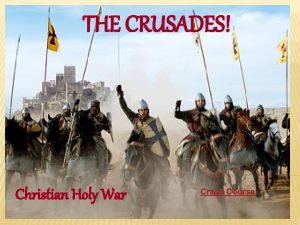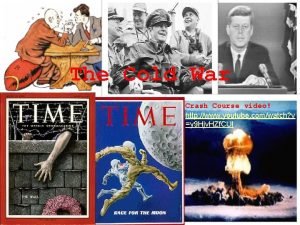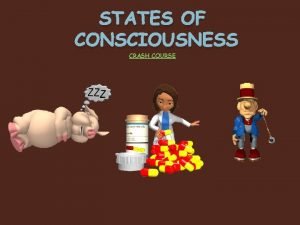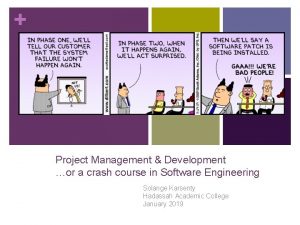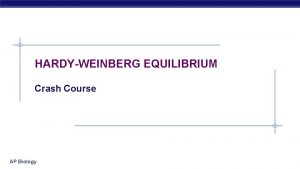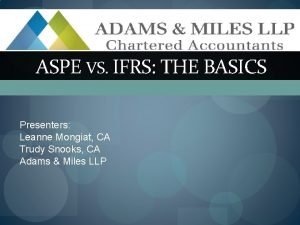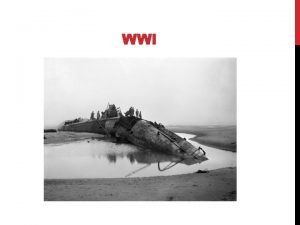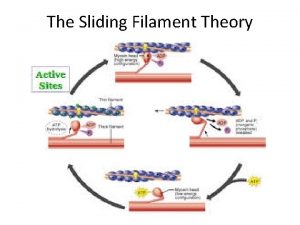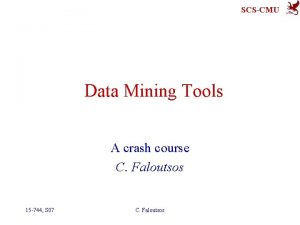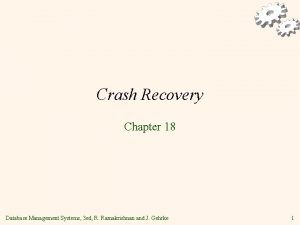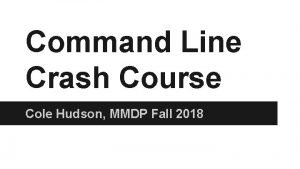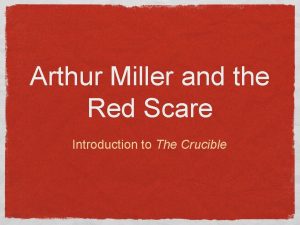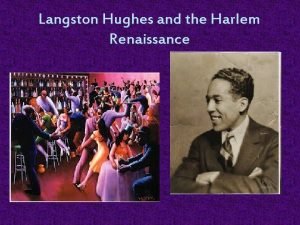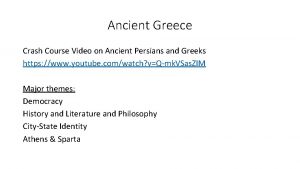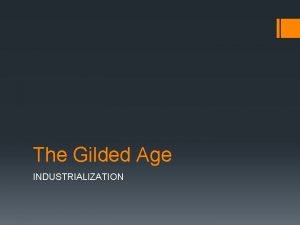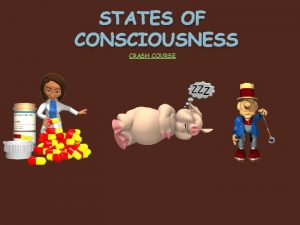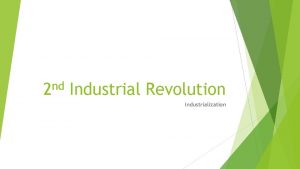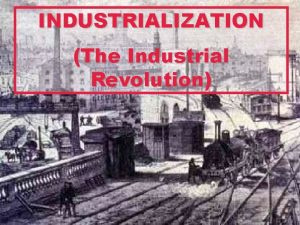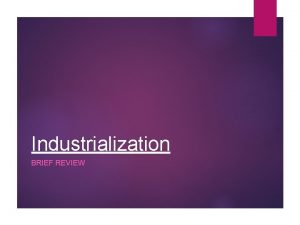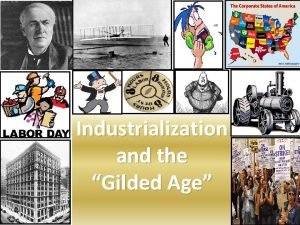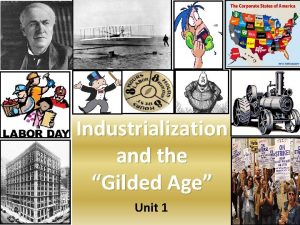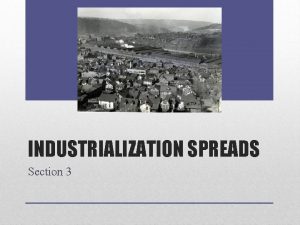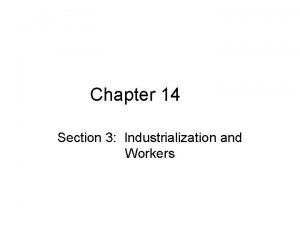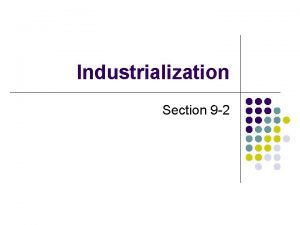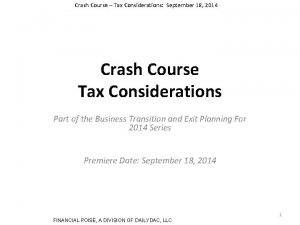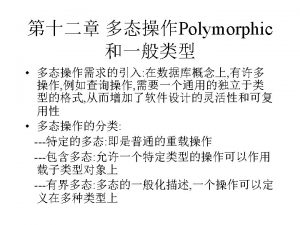Industrialization Module 3 CRASH COURSE Industrial Age Section











































- Slides: 43

Industrialization Module 3 CRASH COURSE: Industrial Age

Section 1: The Expansion of Industry: • Main Idea: At the end of the 19 th century, natural resources, creative ideas, and growing markets fueled an industrial boom. • Why it Matters Now: Technological developments of the late 19 th century paved the way for the continued growth of American Industry. • Key Terms: • Bessemer Process • • • Key Names: Edwin L. Drake Thomas Alva Edison Christopher Sholes Alexander Graham Bell

Section 1: The Expansion of Industry: • As the settlers continued to push west, America was still largely agricultural – that will all change • 1920’s leading industrial power in the world • 1) Natural Resources • Oil, coal, iron, streams, farmland • Coal was cheap resource • Cleveland + Pittsburg • 2) Governmental support • Free Market Economy • Coin money, tariff on imports, patents • Laissez Faire – government leaves the business sector alone • 3) Urbanization • 1800 – 5 Million people • 1900 – 76 Million • 4) Technological innovations • Inventions, transportation, communication, factory systems

Black Gold: • Native Americans • Used oil for medicine and fuel • Europeans used Kerosene as fuel • In 1859, Edwin Drake • used a steam engine to drill for oil • Titusville, PA • This started an oil boom throughout the Midwest and Southern States • Ohio, Kentucky, Illinois, Texas • Cleveland Pittsburg emerged as oil refining cities

Bessemer Steel Process: • Natural resources • Coal and Iron • Plentiful throughout the US. • Samuel Slater – • Left England, brought inventions and techniques • Andrew Carnegie is soon going to use the Bessemer Process • When you removed the carbon from iron, the result was a lighter, more flexible and rust resistant compound – Steel (Bessemer process) • Henry Bessemer

National Markets and the Expansion of the Railroad • Railroads helped tie the nation together by lowering transportation costs railroads. • Allowed manufacturers to reduce prices, attract more buyers, and increase business.

New Uses For Steel: • The railroads, with thousands of miles of track, were the biggest customers for steel • Other uses emerged: barbed wire, farm equipment, bridge construction (Brooklyn Bridge- 1883), and the first skyscrapers Brooklyn Bridge: NYC • Steel will change the construction industry and America’s economy • Growth of cities • Jobs, urban society/culture • Increase trade • Rest of the world look to America for trade

Inventions Promote Change • Electricity • Thomas Alva Edison perfected the incandescent light bulb in 1880 • Later he invented an entire system for producing and distributing electricity • Carbon Filament • Lewis Latimer Thomas Edison: History. com “One percent inspiration and • Improved the lightbulb – invented the carbon filament 99 percent perspiration. ”

Inventions • Typewriter • Christopher Sholes invented the typewriter in 1867 • His invention forever affected office work and paperwork • It also opened many new jobs for women • Mostly stayed at home to take care of the family • Telephone: • Alexander Graham Bell • Thomas Watson unveiled their invention in 1876 • We are still using their invention today

Section 2: The Age of the Railroads: • Main Idea: The growth and consolidation of railroads benefited the nation but also led to corruption and required government regulation. • • Key Terms: Transcontinental Railroad Munn vs. Illinois Interstate Commerce Act • Why it Matters Now: Railroads made possible the expansion of industry across the United States.

The Age of Railroads • As railroad companies continued to grow, their influence over others became out of control • “charge what the traffic will bear” • Had a monopoly over their area • High Prices • Pooling Agreements – secret agreements between companies to raise prices • Government began to loan money and grant land to Railroad Companies. • Politicians were bribed https: //www. youtube. com/watch? v=kl 0 lx. IMMb 9 E • Campaign contributions • Free RR passes • New reforms will be needed to keep the railroad companies in check

A National Network: • The transcontinental Railroad - cross country route, connecting many cities. • Union Pacific and Central Pacific RR Companies • Promontory, Utah May 10 1869. • Out-of-work Civil War vets and immigrants from China and Ireland provided most of the difficult labor • Railroad and Time zones • Before 1883, each city still operated on its own time • Professor C. F. Dowd proposed dividing the earth into 24 time zones • The U. S. would be divided into 4 zones: the eastern, Central, Mountain, and Pacific

THE UNITED STATES IS DIVIDED INTO 4 TIME ZONES

C. Opportunities and Opportunist 1. Supply and Demand • Railroads require great supply of materials, parts • Iron, coal, steel, lumber industries grow to meet demand 2. New Towns and Markets • Railroads link isolated towns, promote trade, interdependence • • • Nationwide network of suppliers, markets develops Towns specialize, sell large quantities of their product nationally New towns grow along railroad lines

Cornelius (“The Commodore”) and W. H. Vanderbilt • Cornelius. Vanderbilt • Created a network of Railroads • Linked smaller railroads together • Decreased time to travel from city to city. • • An active philanthropist, giving extensively to a number of philanthropic causes: • Funded the Metropolitan Opera • Funded College of Physicians and Surgeons at Columbia University. • In 1880, he provided the money for Vanderbilt University in Nashville, Tennessee

Pullman and the Sleeper car • George M. Pullman • Factory owner • Pullman Palace Car Company • Built Sleeper/ dinning / parlor cars • Pullman built a town for his employees • Housing, parks, factory • Provided his employees with basic needs • Doctor offices, shops and athletic fields • Pullman Company controlled the town • No loitering on front steps, no alcohol. • Violent strike due to low pay and high rent • Slashed wages, outlawed saloons

• Business owners desired control and profit • Credit Mobilier • Construction company formed in 1864 by Union Pacific RR Company • “Dummy Company” • Stock holders gave contact to lay track • 2 to 3 times the cost – profited and paid congressmen • Bribe Congress to pass RR Laws/Acts • Vice President • Congress investigated • Public figures kept profit, but Republican party took a hit.

The Grange and the Railroads: • Farmers upset • Misuse of government land • Sold to other businesses and not settlers • Fixed the prices • Charged customers differently • Farmers had no alternative method of shipping • Farmers create and join the Grange • Farmers (with the help from the Grange) continued to push for fairness in the railroad industry – and they got political! • Granger Laws – prohibit discrimination in Railroad shipping • They got the Supreme Court to pass…. . • Munn vs. Illinois: States were given regulation control of railroads by the Courts

Interstate Commerce Act: • In 1887, the Federal government reestablished their control over railroad activities • Congress passed the Interstate Commerce Act – federal government regulation of railroads • Set a standard of governmental regulation on private businesses • Can’t discriminate passengers by special rebates • Prohibit the amount they charge for short and long hauls • Rates should be reasonable and just • 1906 – The Hepburn Act allowed the ICC to set rates and end numerous monopolies • Panic of 1983 – worst depression of the time, many RR companies started to fail.

Section 3: Objectives • By the end of the lesson, I will be able to: • 1. Identify management and business strategies that contributed to the success of business tycoons such as Andrew Carnegie. • 2. Explain Social Darwinism and its effects on society. • 3. Summarize the emergence and growth of unions. • 4. Explain the violent reactions of industry and government to union strikes.

Section 3: Big Business and Labor • Main Idea: The expansion of industry resulted in the growth of big business and prompted laborers to form unions to better their lives. • Terms: • Vertical and horizontal integration • Social Darwinism • Sherman Antitrust Act • American Federation of Labor (AFL) • Industrial Workers of the World (IWW) • Why it Matters Now: Many of the strategies used today in industry and in the labor movement, such as striking, have their origins in the late 19 th century. • • • Names: Andrew Carnegie John D. Rockefeller Samuel Gompers Eugene V. Debs Mary Harris Jones

Section 3: Big Business and Labor • Andrew Carnegie was one of the first industrial tycoon • Owned the entire steel industry • “rags to riches” • Supported charities Carnegie Mellon University • Immigrated to USA when he was 12. • At 18 he was local superintendent of the Pennsylvania RR company • His boss, Thomas, Scott gave Carnegie the opportunity to buy stock in the company. • He entered the steel industry in 1873 after making BIG $ with the railroad industry • Carnegie attempted to control as much of the steel industry as possible http: //www. history. com/topics/andrew-carnegie

Rationalizing Big Business • Social Darwinism • Used Darwin’s theory to explain business, promoted by Harvard professor William Graham Sumner • Natural Selection, Survival of the Fittest • Laissez-faire -policy that US had followed sinception to not allow govt. to interfere with business • Govt. should not interfere • Gospel of Wealth -belief that the wealthy are “chosen by God” to be successful and were therefore responsible to look out for the well being of those less fortunate. • Many Industrialist shared wealthough rarely through direct welfare. Started museums, etc. • Captains of Industry: a positive idea that industrial leaders worked hard and deserved their wealth

Carnegie Business Practices: • Carnegie initiated many new business practices such as; • 1. Searching for ways to make better products more cheaply • Owned the entire steel industry • Iron Ore mines • Mills, Railroads, steamships • Undersold competitors • Drove out companies • 2. Accounting systems to track expenses • ANDREW CARNEGIE Balance the budget • 3. Attracting quality people 1835 -1919 http: //www. history. com/topics/andrewcarnegie/videos/the-men-who-built-americaandrew-carnegie • Stock options • Sense of ownership • Benefits

Carnegie’s Smart Plan: • Vertical integration - buying out his suppliers coal fields, iron mines, ore freighters, and rail lines • Horizontal Integration – buying out companies that produce similar products

John D. Rockefeller • He was a co-founder of the Standard Oil Company, which dominated the oil industry and was the first great U. S. business trust • As kerosene and gasoline grew in importance, became the world's richest man and the first American worth more than a billion dollars • Often cited as the richest person in history • Like Carnegie, was a philanthropist under the Gospel of Wealth: • • • An abolitionist Creator of Spelman College Major donator to the University of Chicago and other major medical universities • Owned a large portion of real estate in Manhattan, NYC

J. P. Morgan • Industrialist and financier who started U. S. Steel from Carnegie Steel and other companies • Became 1 st billion- dollar corporation • Bailed out the U. S. economy on more than one occasion

Social Darwinism • Charles Darwin – Evolution • Survival of the fittest • Herbert Spencer – English Philosopher • Social Darwinism – evolution of human society • Way to justify Laissez Faire marketplace. • Success and failure in business was governed by natural law. • Success = individual responsibility and high work ethic, then came riches

Business Growth and Consilidation • Horizontal integration- merger • “if can’t beat em’ join em’” • These kinds of business practices could result in a monopoly - complete control over an industry • Example: • In 1870, Rockefeller Standard Oil Company owned 2% of the country’s crude oil • By 1880 – it controlled 90% of U. S. crude oil • Is this ok? http: //www. history. com/topics/john-drockefeller/videos/the-men-who-built-americamonopoly

Robber Barons: • As more and more monopolies formed and abused their power, critics began using the term “Robber Barons” • Bought other companies out • Rockefeller lowered his prices of oil • • • Lower than cost to produce it Controlled the market then hiked prices Made its own barrels, cans, and whatever else it needed. “Pay nobody a profit • Even though they made LOTS of $, they still gave back (schools, hospitals, etc. ) • Rockefeller gave away more than $500 million • Carnegie donated about 90% of his earnings • $350 Million • Built 2, 509 libraries around the world • ”

Sherman Anti-Trust Act: • The government had to respond – the “robber barons” were getting way to powerful. • Stifle competition = monopoly, bad for capitalism • Sherman Anti-Trust Act made it illegal to form a monopoly (Trust) • This was tough to govern • – big companies would just split up into smaller companies • Standard Oil – just formed one corporation • Government couldn’t enforce the Act • North advanced during the industrial boom! • South still recovering from the Civil War • Southern farmers were at the mercy of Railroad companies • Hope was in mining tobacco, furniture and cotton. • South didn’t have the capital to expand

Lesson 4 Rise of Labor Movement

Labor Unions Emerge • Why? ? • Low wages, unsafe working conditions, drew workers together to try to improve conditions. • No vacation, sick days, workers comp, etc. • Working conditions bad – dirty, poorly ventilated, led to injuries. • Repetitive takes on sometimes faulty equipment. • In 1882 675 workers killed. • Low wages - whole families had to work, even children as young as 5.

Labor Unions Emerge: • WORKING CONDITIONS • Workers were working 6 -7 days a week for more than 10 hours a day • In 1882, an average of 675 workers were killed PER WEEK on the job • Workers realized they needed to organize to get change to happen • Workers created Unions to negotiate wages, hours, conditions, striking • Everyone in the family had to work • Wages were so low • $3 for skilled work and $1. 50 for unskilled work a Day • Women and Children HAD to work • Some children did not go to school and went to work • 8 yr olds • 27 cents for a 14 hr day • Andrew Carnegie earned 23$ million a year


Striking and Violence: • Skilled workers started to organize • NLU – National Labor Union 1866 • CNLU – Colored National Labor Union • Unions fought for a 8 hr work day • Knights of Labor – open to all workers regardless of gender, race or skill level • Equal pay for equal work • AFL – American Federation of Labor • Collective bargaining • Negotiations between workers and business owners • Some strikes, turned deadly – labor leaders and • Eugene V. Debs – labor leader that helped to organize unions • • Include all skilled and unskilled workers Outcomes – 1. Companies learned to treat their employees better 2. Unions became more powerful

The Growth of Labor Unions • Collective Bargaining • Negotiating as a group with their employers • Higher wages, better conditions, lower rent • Strike – workers refuse to work • Local, state, region, country, groups. • Unions • National Trades Union – 1833 • Changes start • 10 hr days, 6 days a week (mid 1800’s)

Labor Unions • Knights of Labor – 1869 • Social gains for unskilled and skilled workers • Uriah Stephens • Recruited women + African Americans • Terence V. Powderly – took over • Used collective bargaining, strikes, boycotts • American Federation of Labor - 1886 • Samuel Gompers • Skilled workers, 100’s of different specific crafts, • Union Dues • Wages, Hours and conditions • Outcomes – • 1. Companies learned to treat their employees better • 2. Unions became more powerful


• Haymarket Strike – May 1886 • Haymarket Square Chicago • Strikers and police exchange violent attacks • Protestor threw a bomb • 8 anarchists tried for murder – 4 executed • Haymarket Riot • People feared the Knights of Labor / Strikers • Homestead Strike – • Homestead Penn. • Andrew Carnegie steel plant workers strike • Hires – Henry Frick – Pinkertons (private police force) • Several workers killed. • Public opinion turns against unions.

Labor Unrest • Pullman strike (1894) • Started in Chicago 3, 000 railway workers were laid off and wages cut 25 -40 percent. • President Cleveland sent in federal troops to protect interstate commerce. • Eugene V. Debs and the Socialist Party • Industrial Workers of the World • Fought for Unskilled Workers • Radical Unionists • Miners, Lumberers, dock workers

Strikes turn Violent • Labor unrest • 1881 -1905 37, 000 strikes • Yellow dog contracts – promised not to strike or form unions • Great Strike of 1877 • Ohio and Baltimore RR workers struck • Stopped interstate trade • National Guard came in to put down the strike • Haymarket Affair • Chicago 1877 • Worker was killed and several injured at the Mc. Cormick Harvester plant • Rioters tossed a bomb at the police • Police fired back • Eight organizers were charged and one hung • Police started to become Anti-Union • Marry Harris Jones • Most prominent female union organizer • Led to expose and end child labor

Impact of Labor Unions • Business owners backed by courts against unions • Unions denied legal protection • Collective bargaining, strikes became strategies
 Industrialization crash course
Industrialization crash course Iron age dates
Iron age dates Iron age bronze age stone age timeline
Iron age bronze age stone age timeline Chapter 19 section 1 dawn of the industrial age
Chapter 19 section 1 dawn of the industrial age Crash course molecular biology
Crash course molecular biology Unity over the shoulder camera
Unity over the shoulder camera Gas laws crash course
Gas laws crash course Crash course crusades
Crash course crusades Cold war crash course
Cold war crash course Crash course altered states
Crash course altered states Crash course psychology 29 answers
Crash course psychology 29 answers Movable muscle
Movable muscle Traversy media react native
Traversy media react native Project management crash course
Project management crash course Met et prop but pent hex hept oct
Met et prop but pent hex hept oct Crash course ap bio
Crash course ap bio Crash course existentialism
Crash course existentialism Computer architecture crash course
Computer architecture crash course Crash course cardiovascular system
Crash course cardiovascular system Cellular respiration songs
Cellular respiration songs Calculus crash course
Calculus crash course Depreciation aspe
Depreciation aspe Robotics crash course
Robotics crash course Crash course ww1
Crash course ww1 Uml crash course
Uml crash course Crash course sliding filament theory
Crash course sliding filament theory Data mining crash course
Data mining crash course Schizophrenia crash course
Schizophrenia crash course Ros crash course
Ros crash course Cognitive psychology crash course
Cognitive psychology crash course Physical chemistry crash course
Physical chemistry crash course Crash course personality
Crash course personality Recovery concepts in dbms
Recovery concepts in dbms Woo hoo
Woo hoo Command line crash course
Command line crash course The crucible crash course
The crucible crash course Crash course english grammar
Crash course english grammar Weathevr
Weathevr Temperate zone latitude
Temperate zone latitude Crash course protestant reformation
Crash course protestant reformation Arms movement
Arms movement Species tree
Species tree Crash course harlem renaissance
Crash course harlem renaissance Crash course ancient greece
Crash course ancient greece
